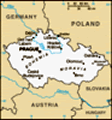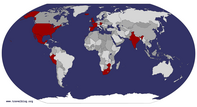Advertisement
Published: February 3rd 2011
Waking (relatively) early we breakfasted and walked to the metro. Since we trekked the length of Wenceslas Square twice yesterday our feet were already aching and despite the assurances of the hostel owner that Prague Castle is in walking distance we opted to make life a little easier on ourselves. We got off the metro at a pretty square and set off for the castle. We walked along the street and found some beautiful gardens below the castle, but unfortunately they didn't offer access to the castle itself and we had to backtrack.
Finding the right route we began a steep uphill walk. Marching across stone in flimsy sandals in the heat of the sun wasn't the most relaxing beginning to our day of sightseeing. As we climbed higher we began to see the view of Prague growing ever wider, until we were looking across an expanse of red rooves and forrested hills. We saw a little cafe with a small terrace and stopped for a drink, our decision in no way affected by our aching feet! We sat by a large window in a warm patch of sunlight sipping cool fruit juice and admiring the view. Eventually we decided we
had to move on or risk getting to midday without actually having done anything. We left the cafe and crested the brow of the hill where we saw the full view across the city below.
We passed between the guards at the gate and entered the castle complex. We walked alng the street between buildings and arrived in a large open square surrounded by buildings, with the large cathedral standing in the centre. What immediately begame apparent is that Prague Castle isn't really a castle at all. From a distance what I had seen as a castle is in fact the cathedral, while the rest of the castle buildings did not fit my image of castles which fall into the categories of grey Norman stronghold or pretty fairytale turrets.
We started our sightseeing with St. George's Basilica, the oldest church building within the Prague Castle complex. It is also the best-preserved Romanesque church in Prague and was founded by Prince Vratislav between 915 and 921. It was later enlarged in 973 with the building of St. George's Benedictine Convent, rebuilt following a fire in 1142, and the current Baroque facade dates from 1671-1691. The inside was cool and despite the
tourists there was a calm peaceful feeling inside. The inside is beautiful and I especially liked the wall and ceiling paintings around the altar, mostly the work of the work of V.V. Reiner.
We wanted to visit the cathedral but the queue seemed to wind halfway arond the exterior so we waited until later. We entered the Old Royal Palace, which dates from the end of the ninth century, but has had so many additions and alterations that the current structure bears little resemblance to the original palace. We entered from the Vladislav Hall which from the 16th century was mostly used for royal entertainments and functions. We saw replicas of the Czech crown jewels and then walked through adjacent chambers elaborately decorated with coats of arms across the walls and ceilings and then along the outer balcony and back into the hall. We walked up the Riders’ Staircase, built originally to enable knights to enter the hall on horseback, and then saw the All Saints’ Church from above before returning to the outer coutryard.
We next visited the the National Gallery which is housed in St George's convent next to the basilica.
The convent is the oldest in the
Czech Republic and was founded in 973 by Prince Boleslav II of Bohemia and his sister Mlada who became the first abbess of the convent. The Abbess was always a member of the royal family and held the very prestigious position of being able to crown the Bohemian queen.
We strolled through the gallery and eventually returned to the courtyard and had something to eat at a cafe near the basilica. By the time we had eaten the queue around St. Vitus Cathedral seemed to have diminished a little and we finally gained entry to the impressive gothic structure. Work on the cathedral was commissioned by Charles IV and began in 1344 upon the site of an earlier 10th century rotunda. In all, it took nearly six centuries to complete. The cathedral was a beautiful place to walk through and I spent ages admiring the many different styles of stained glass windows.
After the cathedral we walked through the second courtyard and followed the path downwards where we got a good view of the cathedral extrerior, before walking back up and leaving through the main entrance and following the road back into town.
We stopped to buy ice-creams and sat
on a doorstep watching people hurrying up and down the street before continuing on our way. We reached St Nicholas Church in Prague Lesser Town (very confusing as there actually 3 St Nicholas Churches in Prague and we saw the one in the Old Town yesterday). This church was founded by the Jesuits and built in 1703. The church is the masterpiece of Christoph and Kilian Ignaz Dientzenhofer, a father and son duo who constructed many buildings during the Baroque period. Unfortunately, neither lived to see its completion. The building was finished by Kilian's son-in-law, Anselmo Lurago.
We hoped to look inside but found we'd have to pay and since the bell tower was included with our Prague Cards we opted to see that part of the church instead. The tower is an impressive 65 metres high. We mounted the spiral staircase and wound our way up to a small room to view and the outer balcony, then followed the steps further to another small balcony and a room featuring illustrations and information about the legends of church bells. These included St Agatha, a christian matyr who among other tortures had her breasts cut off, the shape of which linked
her to church bells and made her the patron saint of bell ringers. Another story is that the bells of Prague silently fly to Rome on Maundy Thursday before Easter for a blessing from the Pope. The way is led by the big old bells with the little ones following so they don't get lost. Even more bizarrely the story goes that bell metal doesn't forget and therefore one night during World War 1 artillerary men couldn't find their cannons because they too had flown to Rome for a Pope's blessing.
We continued upwards on the now predominantly wooden stairways although as we neared the top my sister got halfway across a wooden balcony and had a complete panic attack because she'd seen between the slats of wood at the very long drop below and couldn't move. For a minute I was genuinally worried she wasn't going to move but eventually she shifted along to the more solid steps at the other end and we reached the final room at the top.
The bell tower was the last “warning tower” in Prague. When there was a fire in Prague, a person in the tower had to ring to warn people
and he had to indicate, where the fire is burning, with a red flag during the day and a lamp in the night. This warning system was abolished in 1891. During the Communist era, the bell tower was used as an observation point by the State Secret Service. We could see how easy it was to observe the city, we seemed so very high and could see what seemed like the entire city. I was a little bemused at the sight of a urinal at the top (fotunately with a sign declaring it not for use).
After the church tower we walked to Charles' Bridge where on realising our Prague Card got us entry to the tower museum there we began to climb another tower. We climbed several staircases and even I began to have enough of heights as my sandal started to slip off and as I jammed my foot back in realised my entire leg could fit through the gaps between the steps. I explored the tower museum barefoot for the most part. Each room contained a few exhibitis and then another wooden staircase led on upwards. The final staircase was interesting as it stopped at the ceiling
and a doorway led outside to the right. It was a bit of a high sideways step and the door was very heavy and hard to hold while climbing up. We had to take off our shoes and bags and go one at a time taking turns to hold the door open. Outside at the top of the tower we had another great 360 degree view of the city and enjoyed th eviews and fresh air until we had to the energy to go down all those stairs again.
We walked across Charles' Bridge and then decided to have another rest. We stopped at a Chinese buffet near the bridge and stocked up on spring rolls and noodles and other traditional Czech delicacies!
Afterwards we took a tram towards Petrin Hill, apparently because one can't have too many view of Prague in a day! We had a little confusion over paying for the tram, and then the funicular before realising all public transport as included on the icket we'd bought at the metro. We walked out into a beautiful rose garden and briefly visited the observatory and got to view Venus through the biggest telescope I've ever seen.
We then
found the observation tower. A small replica of the Eiffel Tower it was built in 1891 for the Jubilee Exhibition and stands 60 metres high. Knowing we weren't going to be defeated by a few more steps we bought more water and started up the 299 steps to the top. The tower has a clever system where two sets of steps wind around each other allowing people to go up and down on different staicases and minimise collisions. The views were amazing. We were late enough in the day that the sun was begining to set and Prague's rooves glowed warmly and the river sparkled and it was just breathtaking (literally breathtaking too as I feel like we have climbed every step in the city today)
Making full use of our Prague Cards we visited the 'mirror maze' which was a little underwhelming and then collapsed in the rose gardens to relax. We returned to Charles' Bridge before full sunset and then walked to the nearest metro station... but it was a twenty minute walk! We came back to the hostel hobbling from the foot punishing day we spent and certain tomorrow is going to have to be a more
relaxing day.
Advertisement
Tot: 0.319s; Tpl: 0.021s; cc: 33; qc: 144; dbt: 0.2529s; 1; m:domysql w:travelblog (10.17.0.13); sld: 1;
; mem: 1.6mb






















